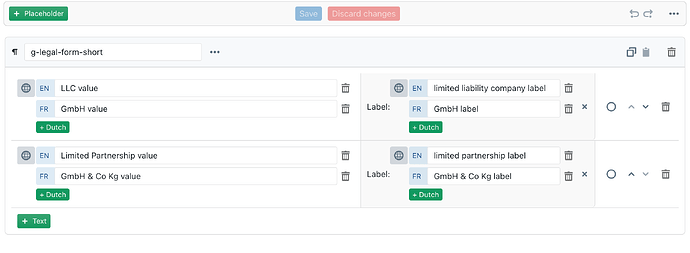Hello everyone,
I have run across the following issue. Whilst I understand that this might just not be possible with Clause9, I still appreciate any input on the topic.
I have a bilingual Power-of-Attorney document (“PoA”) which uses repeating-list datafields to add information about the principal party, such as name, legal entity type or company seat. I am using repeating-lists in order to create multiple PoA’s at once, one for each contracting party. The PoA is set to “Repeat:” in Binder settings per #party^names (also a repeating-list datafield).
For the Q&A, I have created global placeholders as predefine answers. For example, for the repeating-list datafield “legal entity types”, I have:
- limited partnership
- limited liability company
- entrepreneurial company with limited liability
- [English free text entry]
This works very well for creating the english PoA, but I am struggling with a bilingual version. For the list above, the german terms are as follows:
1a. GmbH & Co. KG
2a. GmbH
3a. UG (haftungsbeschränkt)
4a. [German free text entry]
If I copy my english clauses, translate any static text and leave the concepts with datafields, then the english terms just appear in the german version (via datafields), which is not what I want.
Whenever a term is selected for one language, the corresponding term should appear in the other language - so 2) “limited liability company” in english should always display 2a) “GmbH” in german.
I have looked at Q&A settings and the global placeholders, where I tried setting multilingual labels:
However, I suspect these labels only affect the description shown to the user, not the data filled into the datafield. Is that right?
If so, is there a way to achieve what I am trying to do? Are (repeating-list) datafield entries only intended to be language-neutral, or is there a way to have selection (1) in Language A autofill (1a) in Language B?
I suspect it might be possible to achieve this with concept labels: creating a #legal-entity-type concept and giving it bilingual labels, then working with change sets in the Q&A. However, if I want to create 3, 5 or n PoAs, each party could have a different legal entity type. From my understanding, having a concept with different labels would set the same label for all repetitions of the document. This is one of the reasons I moved away from using concepts and opted to use repeating-list datafields instead, so that I could have repeated clauses/documents with varying information.
I have two potential workarounds/solutions I am considering that could allow me to keep using repeating-list datafields:
-
Option 1: Work with global snippets to create in-clause translation logic for the german clauses (so if #party^legal-entities-type is “1)”, display “1a)”; etc.).
-
Option 2: Add a special character into the global placeholder, then use special functions to only pull the datafield entry up-to or from that special character for the english and german versions, respectively. So if the datafield would be filled with “[english] | [german]”, I would try to create a function that pulls only “[english]” in the english clause, and “[german]” in the german one. This could allow users to include new terms in a single Q&A field, using the separator to split by language.
I see potential issues with both options I am considering. Is there a setting that I have overlooked?
Thanks for any input!
Best
Kai




